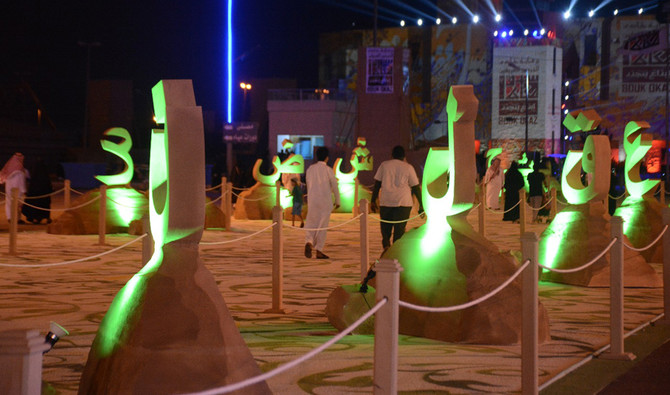TAIF: More than 50 artists from across Saudi Arabia took part in the creation of a 560-square-meter green mural at Souq Okaz, according to Mamdouh Salem, the CEO of Rowad Media.
Salem said: “The mural is the first to be painted in the form of the word Okaz in Arabic and in this size.”
The artists’ paintings, he said, captured the Kingdom’s landmarks, its achievements, Vision 2030, Souq Okaz, Arabian horses, Arabic alphabets and ancient life in Souq Okaz.
The CEO pointed out that each of the participating artists will display four of his paintings on the mural’s site. Six sculptors from within the country — Ali Al-Tekhis, Mohammed Al-Thaqafi, Ali Al-Hassan, Talal Al-Tokhais, Saeed Al-Zahrani and Ali Asiri — participated for the first time this year in creating the mural
The 12th Souq Okaz festival has brought together several sculptors for the first time at the event, said Al-Thaqafi.
“Each of us (sculptors) gets inspired by Souq Okaz, its culture, and its future outlook.” He said Souq Okaz takes several steps forward every year.
“In 2009, we had prepared 22 granite rocks and written pre-Islamic as well as Islamic poems on them,”Al-Thaqafi said.
“There were several unsuccessful attempts in the past few years until our dream became true this year and now we have a forum that will continue in the coming years.”
Salem told Arab News that the 1,800-square-meter Science Oasis painting of Arabic alphabets was created by 60 artists, including designers, architects, and workers.
“The painting aims to bring attention to Arabic alphabets since we are in Souq Okaz, which is linked to Arab history and the lives of Arabian tribes,” he said.
“It took the artists 30 days — 12 hours a day — to finish this painting.”
Salem said there was a suggested plan to design an oasis or garden for Arabic alphabets through which visitors can walk and take pictures.
The Arab Republic of Egypt, the guest of honor at the festival this year, provides several performances, including the Egyptian opera and takht.
Egypt’s Minister of Culture Inas Abdel Dayem said her country’s participation was part of a strong relationship between the two countries.
Wood-carving artisans
Artisans restored the splendor of Souq Okaz Avenue, coming from different parts of the Kingdom to display their creative works during the festival.
The avenue was lined with dozens of artisans with their carvings on wood, Sadu weaving, Arabic calligraphy and other arts that aim to revive Saudi heritage and crafts.
Wood carver and carpenter Fawzi Al-Zahrani said the avenue displays “aim to acquaint the new generation with the crafts of their ancestors with a view of preserving these trades and professions from disappearing.”
Al-Zahrani said he uses the finest wood to carve and manufacture old kitchen utensils, as well as other woodworks that mimic the old southern environment of the Kingdom.
Taif Institute pavilion
The Taif Industrial Secondary Institute is participating in the festival with a pavilion displaying models designed and produced by the institute’s students.
Visitors to the pavilion start their tour at the production section, which displays auto parts produced by the students. Also on display are commemorative shields made by the institute and used in public and private events.
The pavilion features a section dedicated to carpentry and welding, where visitors are introduced to furniture, windows, doors and bedrooms made from the finest wood.
Visitors can also see a car model with each part painted in a different color, representing the function of each component. The car represents the various skills the students learn at the institute.The pavilion contains other important sections, including electronics and power displays.
One of the main attractions during the 12th edition of the event is the Sadu and traditional carpets pavilion. Visitors can see hand-embroidered clothes for children, face covers for women, as well as tassels for horses, and special items for weddings and religious events.
Also on show are Sadu woven rugs representing the Two Holy Mosques, the logo of Saudi Arabia, and map and images of King Salman, Crown Prince Mohammed bin Salman, the princes of some regions and the Vision 2030 logo.













